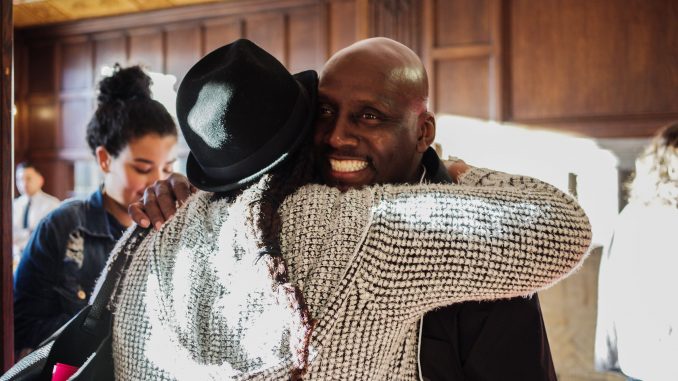
Lori Pompa, a criminal justice instructor, first thought to combine Temple students and prisoners in an academic setting in the late 1990s.
The idea came to her when she took a group of her criminal justice students for a tour of a prison in Dallas, Pennsylvania. She noticed how her students were deeply engaged in discussion with a group of incarcerated people after the tour. It inspired her to create the Inside-Out Prison Exchange Program in 1997.
Last Thursday, staff members and current and former participants gathered in Mitten Hall to celebrate the program’s 20th anniversary. Inside-Out is an educational program where students and incarcerated people take a semester-long course together, all behind prison walls.
Today, Inside-Out has expanded to an international level. The program has spread across the United States and to nine different countries and has impacted more than 30,000 students.
“As we sit here in this moment, there are probably Inside-Out classes happening somewhere on the globe,” Pompa said in a speech on Thursday.
The program promotes the idea that “society is strengthened when higher education/learning is made widely accessible…often across profound social barriers,” according to the Inside-Out website.
Charles Brown, a formerly incarcerated person and an Inside-Out program alumnus, said one of his most memorable experiences with Inside-Out was working with a student who was convinced to oppose the death penalty, even though she had previously supported it.
“When it was all said and done, we learned, and some perspectives were changed,” Brown said. “I added everything I learned to my character.”
Brown, who received a life sentence when he was under the age of 18, recently had his sentence commuted following a 2016 Supreme Court ruling that helped release some people from prison who were sentenced to life in prison as minors. Brown was incarcerated for 30 years at Chester State Correctional Institution in Pennsylvania.
“The program helped students from the outside get a better perspective of the criminal justice system and society as a whole, not just reading it from a book,” Brown said. “They’re seeing that people who have been deemed as monsters by society have personalities and they’re not these monsters people would have them believe.”
“Inside-Out makes a difference in a way that most other courses really don’t,” President Richard Englert said at the event on Thursday. “Both the inside students and the outside students learn lessons that they couldn’t have learned any other way.”
Marietta Martinovic, who started the first Inside-Out program in Australia, first met Pompa at a think tank at Pennsylvania’s Graterford State Correctional Institution in 2005. She completed her training to become an Inside-Out instructor in 2008. Since then, more than 800 higher education instructors have been trained to teach Inside-Out courses.
“It’s the best part of my work,” said Martinovic, who attended the event on Thursday. “Participating in the Inside-Out program is the best part of being an academic.”
In addition to bringing together program instructors from across the world, Thursday’s event was also a celebration for several former “juvenile lifers.”
One of them, John Pace, who is now a program associate for Inside-Out, said the program fosters understanding on both sides.
“I think it’s about relationships more than anything, you develop relationships with people,” Pace said.
Pace said these relationships allow the program to flourish. As students on the outside and incarcerated students become acquainted, they begin to understand each other as individuals.
Megan McGovern, a senior marketing major, is currently taking an Inside-Out course with incarcerated women at the Philadelphia Federal Detention Center at 7th and Arch streets.
“As much as I tried to put all my assumptions aside, I was still really shocked by the class and how amazing the inside students are,” McGovern said. “It doesn’t feel like I’m in a prison meeting with prisoners. Like it’s just, I’m meeting with these women who have had unfortunate circumstances that put them there.”
“We’ve broken down that wall between us and we’re able to interact just as people,” she added.
Last spring, Maddi Gray, a senior political science and global studies major, took weekly classes at Graterford State Correctional Institution, about a 10-minute drive from her childhood home in Schwenksville, Pennsylvania.
“Even though I grew up so close to a maximum-security prison, you still don’t really think about it as much,” Gray said. “Some other people I was in class with had been living in Graterford prison for decades, so like the entire time I was growing up and going to elementary school and middle school and high school, their lives were fairly consistent.”
Gray is now interning at the Pennsylvania State Capitol in Harrisburg. Having developed close relationships with incarcerated people through Inside-Out, she said she recognizes how little political effort is made to help people in the state prison system.
“I’m interacting with people who have the power, like policymakers and legislators,” Gray said. “It’s just really interesting to see how low a priority…people who are incarcerated are for state legislators.”
“It really opened my eyes to so many different levels of injustice,” she added.
Ian Walker contributed reporting.


Be the first to comment